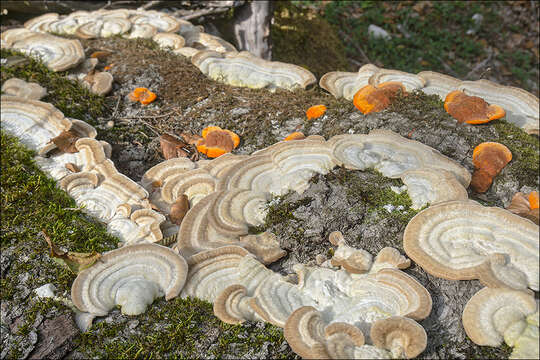Trametes-hirsuta_11

Description:
Trametes hirsuta (Wulfen) Lloyd, syn.: Trametes porioides L.Ibiza, Polystictus hirsutus (Wulfen) Fr., Polystictoides hirsutus (Wulfen) L. Ibiza, Polyporus hirsutus (Wulfen) Fr., Coriolus hirsutus (Wulfen) Pat.Family: Polyporaceae.EN: Hairy Bracket, DE: Striegelige TrameteSlo.: kosmata ploskocevkaDat.: Oct. 6. 2022Lat.: 46.35820 Long.: 13.70098Code: Bot_1485/2022_DSC8789Habitat: forest edge, Fagus sylvatica and Picea abies dominant trees; moderately inclined mountain slope, south aspect; calcareous, colluvial, skeletal ground; partly sunny and dry place; exposed to direct rain, average precipitations ~ 3.000 mm/year, average temperature 7 - 9 deg C, elevation 565 m (1.850 feet), alpine phytogeographical region (M. Wraber, 1969).Substratum: large fallen Fagus sylvatica in its initial disintegration phase not yet decorticated.Place: Lower Trenta valley between villages Soa and Trenta, right bank of river Soa, between abandoned farmhouse Strgulc, Soa 47 and main road Bovec - Vri, East Julian Alps, Posoje, Slovenia EC. Comments (pertain to pictures in the Flicks album Trametes hirsuta): Trametes hirsutais a widespread and very common polypore in my region. It is relatively easy to recognized it by its conspicuous, long, rigid hairs on cap surface, which grow in indistinct zones. Small pores (2 to 4 per mm) are also characteristic. Yet, the polypore may appear in quite different shapes and colors. It is generally whitish or grayish with sometimes barely visible zones, which are at least slightly differ in color and/or hairiness. But it can be also very distinctly zooned with zones of different shades of ocher or light brown. When colonized by algae it may sometimes look also completely green. The pilei margin is usually of the same color as the rest of pilei surface but many times it can be distinctly brownish or yellowish. When it grows on vertical surfaces it forms brackets, many times with a distinct hairy buckle in the center. But when it grows on horizontal surfaces it looks quite differently. It is flatter, thinner, sometimes even concave. Several pilei can grow confluent. Most often it is misidentified with Trametes pubescens, which is similar in habit, but the latter one has never such coarse hairs being much more downier or velvety and thinner. Trametes suaveolens is another similar whitish candidate for a potential misidentification, but this species can be differentiated by its strong smell on anise and smooth cap. It is interesting that the fallen logs and trunks infected by Trametes hirsuta are quite often also infected by a much rarer attractive, vividly orange species Pycnoporus cinnabarinus. This was also the case with the fallen Fagus sylvatica tree shown on Fig. 11. and Fig. 16.Ref.: (1) J. Breitenbach, F. Kraenzlin, Eds., Fungi of Switzerland, Vol.2. Verlag Mykologia (1986), p 286. (2) www.mycoquebec.org/bas.php?trie=T&l=l&nom=Tramete... (accessed Dec.7.2022) (3) www.123pilze.de/DreamHC/Download/StriegeligeTram.htm (accessed Dec. 7. (2022) (4) G.J. Krieglsteiner (Hrsg.), Die Grosspilze Baden-Wrttembergs, Band 1., Ulmer (2000), p 587.(5) T. Lsse, J.H. Petersen, Fungi of temperate Europe, Vol. 2., Princeton University Press (2019), p 920. (6) L. Ryvarden, R.L. Gilbertson, European Polypores, part 2., Synopsis Fungorum 7., Fungiflora A/S (1994), p 657. (7) A. Bernicchia, Polyporaceaes l., Fungi Europaei, Vol. 10., Edizioni Candusso (2005), p 529.
Included On The Following Pages:
- Life (creatures)
- Cellular (cellular organisms)
- Eukaryota (eukaryotes)
- Opisthokonta (opisthokonts)
- Nucletmycea
- Fungi (mushrooms, lichens, molds, yeasts and relatives)
- Dikarya
- Basidiomycota (basidiomycete fungi)
- Agaricomycetes (Mushroom-Forming Fungi)
- Polyporales
- Polyporaceae (bracket fungi)
- Trametes
- Trametes hirsuta
This image is not featured in any collections.
Source Information
- license
- cc-by-nc-sa
- copyright
- Amadej Trnkoczy
- photographer
- Amadej Trnkoczy
- original
- original media file
- visit source
- partner site
- Flickr Group
- ID


